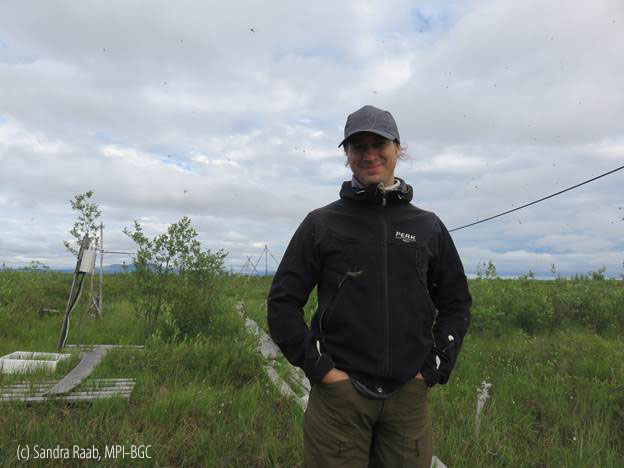
Travelling to the location of a former Gulag in northeast Siberia during the summer of 2017, Martijn describes the challenges of carrying out field work in such a remote but breathtaking environment and also explains why continuous atmospheric monitoring of the tundra environment is vital.
Martijn Pallandt, a PhD student at the Max Planck Institute for Biogeochemistry in Jena, Germany, travelled to the location of a former Gulag in northeast Siberia during the summer of 2017 to prepare for the installation of additional atmospheric sampling equipment in the context of INTAROS. In this story Martijn describes the challenges of carrying out field work in such a remote but breathtaking environment and also explains why continuous atmospheric monitoring of the tundra environment is vital in order to understand how climate change is impacting it.
In July 2017, I travelled with colleagues from the Max Planck Institute for Biogeochemistry to Ambarchik in Northeastern Russia. Located near the mouth of the Kolyma River on the East Siberian Sea, Ambarchik is by all definitions a remote place. The first leg of the journey to Yakutsk was pretty straightforward. But when we arrived in Yakutsk it was a more than comfortable 34ºC. These temperatures were not surprising considering Yakutsk’s extreme continental climate, but unfortunately they were not something that I had considered when packing my bags for the far colder Chersky region (though later in the afternoon we were able to cool down at The Melnikov Permafrost Institute). Lyudmila Lebedova, a scientist working there, was so kind as to show us the institute and the beautiful traditional style district of Yakutsk. The institute houses a cave that leads into the permafrost underneath. This cave functions as a laboratory where scientists conduct long-term experiments under constant below zero temperatures. It was a bit surreal to experience the contrast between the sub-zero temperatures underground and the summer heat a few meters higher on the surface, but definitely interesting.
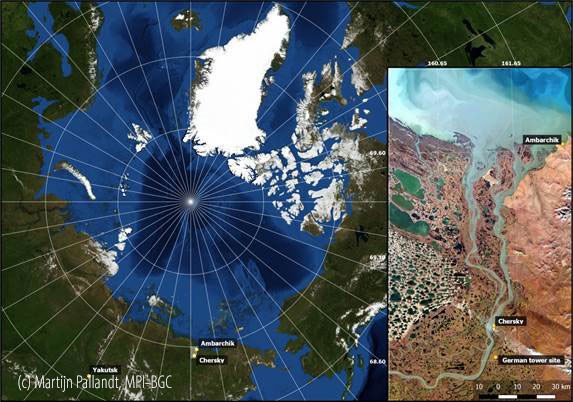
Circumpolar map indicating the location of our study sites. The insert shows the location of our atmospheric tower in Ambarchik, the Northeast Science station in Chersky and the German tower site where our water table experiments take place. Source: Modified from Blue Marble Next Generation, Reto Stöckli, NASA Earth Observatory; insert contains modified Copernicus Sentinel data [2016]; Author M. Pallandt.
The next day we departed for Chersky. I was told I was lucky—they had just started flying with relatively new aircrafts, making the trip shorter and more comfortable. The flight was wonderful; from my spot next to a window I was able to watch the magnificent landscape unfold. Rivers meandered and branched endlessly among forests and lakes interrupted only by the occasional mountain ridge. Only rarely could traces of human activity be seen.
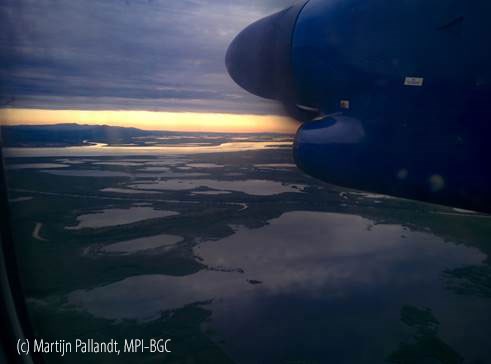
View from the airplane, showing the Kolyma Lowlands region close to Chersky.
The terror of the Arctic - mosquitos
Upon arrival in Chersky we were greeted by… mosquitos. Yes, I was back in the Arctic! Our actual welcoming committee, Sergey and Nikita Zimov, were also there to pick us up. They run the Northeast Science Station in Chersky which is an international hub for science, with researchers from around the world coming there to conduct their experiments in the Arctic. On arrival we were just in time for dinner and, of course, vodka. Vodka, I learned, wasn’t just for the evenings but also for lunch and when having a snack. But it did taste good with the ever-present, delicious but fatty dried fish.

View from the Northeast Science Station, looking over a side branch of the Kolyma River.
Monitoring changes in the tundra ecosystem
The next day we planned to continue on our way to Ambarchik, a boat trip of 120 km down the Kolyma River. Unfortunately, the weather that day wasn’t suitable for river travel, and safety had to come first—several local people die each year on that stretch of the river, so the station staff is extremely cautious not to expose their visitors to unnecessary risks (and can boast a convincing track record in this regard). Instead, we spent the day performing maintenance on our eddy covariance sites, 15 kilometres south of Chersky. At these sites, we are investigating the question of what will happen to a tundra ecosystem if exposed to persistently drier conditions, using a long-term water level manipulation experiment. In this wet tussock tundra a ditch has been dug to drain water, simulating the theorised degradation of tundra underlain by ice wedges. Two eddy covariance towers and an extensive suite of soil and surface water sensors have been installed to identify any changes to the system, split up into a disturbed and an undrained section serving as a control site.
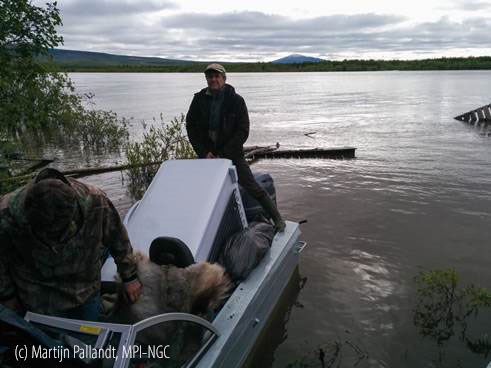
Loading all our equipment and a refrigerator into the speedboat. The high water levels complicate this considerably as the pier has been flooded and is floating away (in the back)
A rather chilly river trip to Ambarchik
The following day the weather greatly improved and we could finally start our trip to Ambarchik. It was a bit of a challenge to get all the equipment, food, people, and a large refrigerator in the speed boats, but we managed and were off on our 5 hour trip by the late morning. With temperatures close to zero, sitting still in an open speedboat gets you cold very fast. But the view from the boat was wonderful, with the low sun, snow topped hills in the background, and nesting birds all around. As we sped over the wide river, the boreal forest slowly gave way to the Arctic tundra and eventually the Arctic Sea.
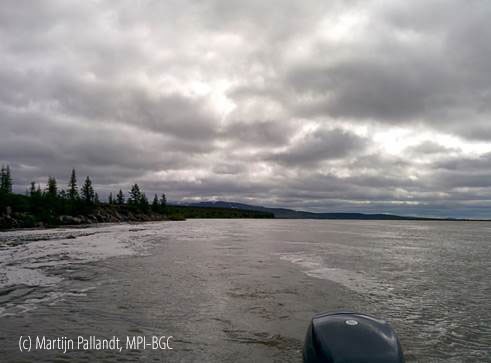
The last cape on the Kolyma River where trees still grow.
Ambarchik, our final location for this trip, used to be a port village that serves the Kolyma region, a position that Chersky has taken over in the course of recent decades. During the Soviet era, it functioned as a gulag and as a large weather station, both of which were established in the 1940s. The gulag has been closed for a long time, and also the weather station has been reduced in size and automated. Now, only two people live and work in Ambarchik. Electricity is provided by a diesel generator, and there is no running water—instead snow is melted, and food is supplied once a year by boat, with the occasional fresh products delivered by people from the Northeast Science Station.
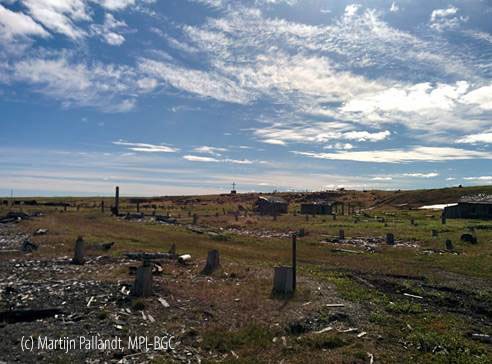
Remnants of the gulag in Ambarchik, with a monument in the back to commemorate the victims.
Maintaining and extending the tower atmospheric sampling equipment
The next days were spent on maintenance of the equipment. In Ambarchik our research group operates a 27 meter high tower where we measure atmospheric Carbon Dioxide (CO2), methane (CH4) and water vapour concentrations as well as other important meteorological variables. Even though our Russian colleagues take very good care of our equipment, and ensure continuous operation with only minor gaps so far, to keep the systems running smoothly instrument maintenance and calibration by Max-Planck personnel is required every year. As is to be expected, also this year our fieldwork had its up and downs. We managed to fix a potentially difficult problem related to flow rates through the gas analysing system within fifteen minutes. On the other hand, during the hectic departure in Chersky earlier that morning I had forgotten my bottles of distilled water that were an essential component for other experiments I had on my to-do list. So I ended up having to make my own distilled water from melted snow. Oh well, no fieldwork is complete without having to improvise a bit!
Check out a short movie about Ambarchik on the INTAROS You Tube Channel.
After my colleagues left to continue with maintenance work around the Chersky observation sites, I stayed for half a week to finish additional calibration experiments with the existing system, and prepare for next year, when we will install an automatic flask sampler. With this flask sampler we aim to monitor more greenhouse gas species and isotopes. These measurements will allow us to better understand sources and sinks of greenhouse gases in the region. When it was time to go back to Ambarchik the weather did not agree, and even the day after the white-capped waves in Ambarchik Bay were a clear sign that no boat would be coming. At least this gave me some time to have a walk through the remains of the gulag and over the tundra. Later in the afternoon, to my surprise, Nikita arrived at the station to pick me up. Apparently there was no wind whatsoever on the Kolyma, but the waves at sea were so high he had to leave the boat in the bay before ours and walk the rest of the way over the tundra. Getting back to the boat was interesting—Dima, the meteorologist at Ambarchik, brought us on a snowmobile, even though the tundra was absolutely snow free at that time. The trip back by boat was possibly more beautiful than the way there, with the river as flat and clear as a mirror.
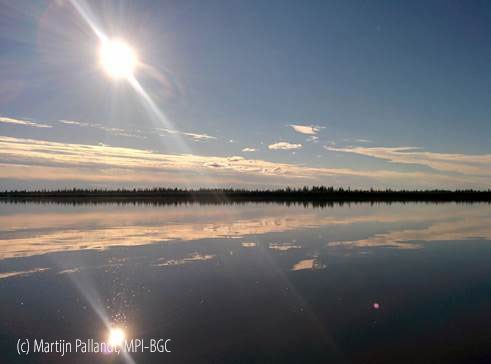
The river Kolyma on the trip back from Ambarchik.
I had planned a buffer of several days around my work at Ambarchik in case of bad weather, but because I had only used two of them, I now had time left to help my colleagues at Chersky with their fieldwork, and to visit two unique sites in the area.
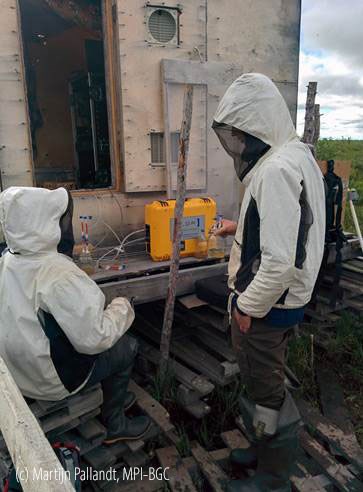
MPI-BGC researchers Sandra Raab and Linus Schauer measuring soil water dissolved methane and carbon dioxide.
One site, the Pleistocene Park, is the life’s work of Sergei Zimov. His theory is that the Arctic tundra and boreal forests used to be a steppe until humans hunted down the large herbivores, thus opening the door for forest encroachment. In this Pleistocene Park, they bring together large groups of herbivores, including species like the yak, reindeer, and bison, in an attempt to recreate the Pleistocene Arctic steppe ecosystem. Their overarching goal is to combat climate change. They claim that in the winter the steppe ecosystem would cause the permafrost layer to be less insulated than the current forests and tundra, and thus help it refreeze each winter. The park is still a work in progress, but it is impressive to see an ecological experiment of this size and I’m curious how it will turn out.
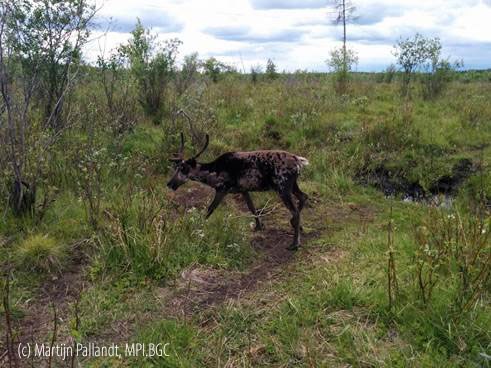
A reindeer at the Pleistocene Park, an open landscape with grasses and low shrubs instead of the boreal forest or tundra vegetation.
The other region I was able to visit between fieldwork was Duvanni Yar (68.631°N, 159.151°E). In this area, the Kolyma River erodes the surrounding hillside exposing the yedoma. Yedoma is old permafrost that formed during the Pleistocene which is very rich in carbon and ice wedges . Because of this erosion, the permafrost and ice wedges are exposed in a way that would otherwise not be visible. It was particularly impressive to see these large ice wedges glisten in the sun while all around them the permafrost thaws. Another side effect of this erosion and thawing of permafrost is that ancient soil layers become exposed. These often contain the bones, teeth, and horns of prehistoric animals. Mammoth tusks are often sought after, especially now China has banned the trade in contemporary Ivory. Mammoth ivory is now used as a substitute but this causes a whole new set of issues.
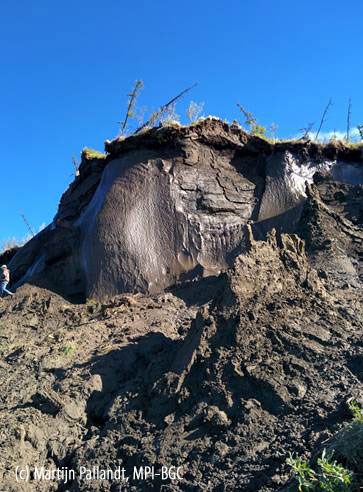
Side view of an exposed ice wedge, The person that can be seen on the left of the photograph higlights the size of such wedges.
Time to head for home
Eventually it was time to return to Germany. This time, I would fly with one of the old Antonov airplanes, a robust but rather uncomfortable AN-24. On the way to the airport, Nikita jested that if it didn’t crash during the last 60 years, it probably wouldn’t crash today, and I suppose there is some logic to that. Either way, while the seat was definitely less comfortable, the view back was just as breath-taking as on the way there.
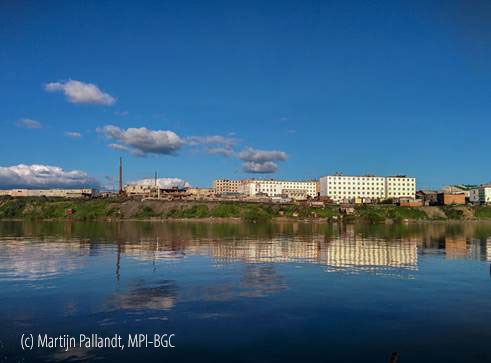
View of the town of Chersky from the Kolyma.
Martijn Pallandt is a PhD researcher at the Max Planck Institute for Biogeochemistry in Jena, where he will work on the INTAROS project’s Arctic GHG monitoring network analysis. Before coming to Jena he worked as a researcher at the Vrije University in Amsterdam, where in the scope of the ICOS-INWIRE project he designed and tested an autonomous eddy covariance system for harsh climates. As part of his masters studies at Wageningen University he conducted an internship at San Diego State University, during which he spent the summer months in Barrow, Alaska to measure CO2 fluxes.
The research mission of the Max-Planck-Institute for Biogeochemistry (MPI-BGC), which is a research institute of the German Max-Planck Society (MPG), is the investigation of the global biogeochemical cycles and their interaction with the climate system. The institute combines strong observational and process-based studies (soil carbon, plant community and growth, vegetation-atmosphere fluxes) with global scale modelling (e.g. vegetation dynamics, global carbon cycle, aerosol). Within the INTAROS project, MPI-BGC will contribute to observational and modeling work focusing on greenhouse gas processes in both the terrestrial and atmospheric spheres. The institute leads Task 3.5 (innovative observations in the atmospheric and terrestrial spheres) and Task 6.5 (data assimilation to advance process understanding in Arctic greenhouse gas exchange), and furthermore contributes to WP2 (GHG observation network evaluation study). All contributions by MPI-BGC will build on the demonstrated expertise in observations and modeling of atmospheric trace gases, and the use of both elements to constrain surface-atmosphere exchange processes and identify key processes in the Arctic carbon cycle.
17/11/2017 Martijn Pallandt, Max-Planck-Institute for Biogeochemistry